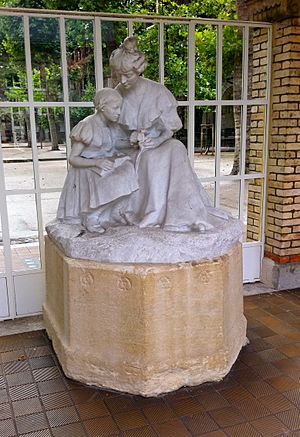Blanche Moria facts for kids
Blanche Adèle Moria (born in 1859, died in 1926) was a talented French artist. She was a sculptor, which means she made statues and figures. She was also a medallist, creating special coins or medallions. Besides her art, Blanche Moria was an educator, teaching others, and a feminist. This means she strongly believed in equal rights for women.
Blanche Moria designed many artworks, including busts (sculptures of a person's head and shoulders), medals, and large monuments. She started showing her art in public exhibitions called "salons" from 1883. She became very well-known and received many requests from the French government to create art.
As a feminist, Moria worked hard to improve women's rights. She especially wanted women to have better chances to get an education, find good jobs, and take part in politics. She was a member of a group called the Ligue Française pour le Droit des Femmes, which translates to the French League for Women's Rights. In 1921, she wrote an article about women artists for a special book called Cinquante ans de féminisme (Fifty Years of Feminism).
Contents
Who Was Blanche Moria: Artist and Activist
Blanche Moria was a remarkable woman who used her artistic skills and her voice to make a difference. She lived during a time when women had fewer opportunities than men. Her work helped to change that.
Early Life and Artistic Journey
Blanche Adèle Moria was born in 1859 in France. We don't have many details about her early childhood, but we know she developed a passion for art. She chose to become a sculptor, a field that was not very common for women at that time.
Moria worked on many different types of art. She made detailed busts of people, capturing their likeness in stone or metal. She also designed medals, which are like special coins given to honor people or events. Her biggest projects included creating monuments, which are large sculptures often placed in public spaces.
Her art was so good that she started exhibiting it in famous art shows called "salons" from 1883. These shows were important because they allowed artists to display their work to the public and gain recognition. Blanche Moria's talent quickly caught the eye of the government, leading to many "commissions." This means the government officially asked her to create specific artworks for them.
Fighting for Women's Rights
Beyond her art, Blanche Moria was a strong advocate for women. She was a "feminist," a person who believes that women and men should have equal rights and opportunities. In her time, women often faced many challenges. They had limited access to education, fewer job choices, and almost no say in politics.
Moria believed this was unfair. She actively worked to change society so that women could have the same chances as men. She focused on three main areas:
- Education: She wanted girls and young women to have the same quality of education as boys. This would help them learn and grow.
- Jobs: She fought for women to be able to get any job they were qualified for, not just traditional women's roles.
- Politics: She believed women should have the right to vote and hold political positions, just like men.
Blanche Moria was an active member of the Ligue Française pour le Droit des Femmes. This group was dedicated to improving women's lives in France. In 1921, she shared her knowledge and passion by writing an article for a collection called Cinquante ans de féminisme. This book celebrated fifty years of the women's rights movement and highlighted the contributions of women artists like herself.
Blanche Moria passed away in 1926, but her legacy lives on. She is remembered not only for her beautiful sculptures and medals but also for her important work in fighting for a more equal world for women.
See also
 In Spanish: Blanche Moria para niños
In Spanish: Blanche Moria para niños


